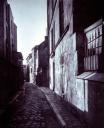Atget came to Paris in the 1890s. Born near Bordeaux, as a young man he embarked as a sailor and cabin boy. Later he became an itinerant actor. Abandoning the stage, he aspired to become a painter, but settled for photography due to his lack of artistic education. He photographed the city of Paris on commission from public and private patrons, but also on his own. He lived an obscure life and died unnoticed. His work was discovered later by the surrealists who considered his achievements as a kind of premonition of Surrealism itself.
The photographs of Parisian streets, walls, facades, windows, storefronts, are indeed marked by a kind of quite expectation. Both intense and distracted in its concentration, in anticipation of things to come, a future drama that is at the same time the disclosure of a time already passed, as an event or a play in its final stages of completion, after the conclusion of the main action.
Through Atget´s works, Paris stages itself, presents itself as the place of a drama about to begin or already concluded. We, spectators have come perhaps too early, or most probably a little too late, and we are able to see the fragmented elements of a plot we are unable to fully grasp the final meaning.
In the majority of his images, Paris is a deserted place. When it appears in Atget´s photographs , the human figure is mostly secondary to the urban space that envelops and defines its inhabitants. The city however displays a sort of disciplined or restrained energy of its own. The city is not the background of a drama written in images by the old actor, but indeed its main character. Van Lier relates Atget images of Paris decayed walls, narrow streets, dormant facades to the concept and process of negentropy, the dissipation of energy (entropy) in physical systems and the counter attempts towards equilibrium.
As an actor, Atget knew the value of the dramatic pause and silence: a kind of music of silence is one important element in his images of deserted streets and buildings and in the mirrors of shop windows reflecting an autonomous world of commodities, liberated from the human intermediaries of commodity circulation: the dream, or nightmare of pure capitalism.
Marcelo Guimarães Lima
The photographs of Parisian streets, walls, facades, windows, storefronts, are indeed marked by a kind of quite expectation. Both intense and distracted in its concentration, in anticipation of things to come, a future drama that is at the same time the disclosure of a time already passed, as an event or a play in its final stages of completion, after the conclusion of the main action.
Through Atget´s works, Paris stages itself, presents itself as the place of a drama about to begin or already concluded. We, spectators have come perhaps too early, or most probably a little too late, and we are able to see the fragmented elements of a plot we are unable to fully grasp the final meaning.
In the majority of his images, Paris is a deserted place. When it appears in Atget´s photographs , the human figure is mostly secondary to the urban space that envelops and defines its inhabitants. The city however displays a sort of disciplined or restrained energy of its own. The city is not the background of a drama written in images by the old actor, but indeed its main character. Van Lier relates Atget images of Paris decayed walls, narrow streets, dormant facades to the concept and process of negentropy, the dissipation of energy (entropy) in physical systems and the counter attempts towards equilibrium.
As an actor, Atget knew the value of the dramatic pause and silence: a kind of music of silence is one important element in his images of deserted streets and buildings and in the mirrors of shop windows reflecting an autonomous world of commodities, liberated from the human intermediaries of commodity circulation: the dream, or nightmare of pure capitalism.
Marcelo Guimarães Lima
revised 14, February, 2009

Avenue des Gobelins (1927)
Notre-Dame, seen from Quai de la Tournelle, 1923

Mercury statue, Jardin des Tuileries, 1906

Jardin des Tuileries, 1907

The Moulin Rouge, 86 Boulevard de Clichi, 1910
source: http://www.gingkopress.com/_cata/ima1/atget-i1.htm
source: http://www.gingkopress.com/_cata/ima1/atget-i1.htm
Le Cirque
Rue de Seine, 1924
Corsets, Boulevard de Strasbourge, 1912
Atget, Eugene (1857-1927) Rue St. Rustique
“20 Photographs by Eugene Atget”, New York, 1956
“20 Photographs by Eugene Atget”, New York, 1956
March 1922 / printed 1956 by Berenice Abbott from Atget’s negative
toned gelatin silver print
21.7 x 17.5 cm.
toned gelatin silver print
21.7 x 17.5 cm.
source: George Eastman House Online Collection










Comments